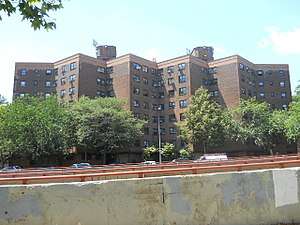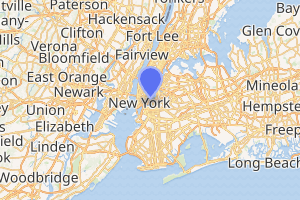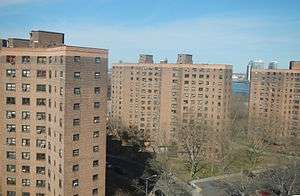Baruch Houses
Bernard M. Baruch Houses, or Baruch Houses, is a public housing development built by the New York City Housing Authority (NYCHA) on the Lower East Side of Manhattan. Baruch Houses is bounded by Franklin D. Roosevelt East River Drive to the east, E. Houston Street to the north, Columbia Street to the west, and Delancey Street to the south.[3] The complex, the largest NYCHA development in Manhattan, occupies 27.64 acres (111,900 m2) (equivalent to fifteen blocks), of which buildings cover 13.4%, a percentage similar to that of most "tower in the park" project designs.[4] It has 2,194 apartments, which house an estimated 5,397 people.[3][5] These apartments are distributed throughout 17 buildings.[3] Baruch Houses I is seven stories tall, Baruch Houses XI, XIII, and XV are thirteen stories tall, and the rest (II-X, XII, XIV, XVI-XVII) are fourteen stories tall.[6] Combined, these buildings have 2.9 million square feet (270,000 m2).[3][5]
Baruch Houses | |
|---|---|
 | |

Location in New York City | |
| Coordinates: 40.7175°N 73.9772°W | |
| Country | United States |
| State | New York |
| City | New York City |
| Borough | Manhattan |
| Area | |
| • Total | 0.042 sq mi (0.11 km2) |
| Population | |
| • Total | 5,101 [2] |
| ZIP codes | 10002 |
| Area code(s) | 212, 332, 646, and 917 |
| Website | my |

Baruch Houses Addition, or Baruch Addition, is an eighteenth building for seniors, built in 1977.[6][7] Baruch Addition is located on Columbia Street, at the start of Rivington Street, and has 197 units in twenty-three stories.[5][6][7]
Development
The Baruch Houses were designed by Emery Roth & Sons[4] and was completed June 30, 1959.[3] Between the construction of LaGuardia Houses and Baruch Houses, 1,650 people were displaced in 1953-1954.[8] It is named after Bernard Baruch, a Wall Street trader, economic advisor during World War I and World War II, and confidant to six presidents.[3]
In 2013, the Baruch Houses were included in Mayor Bloomberg’s 80/20 infill plan that would lease the development's open space to housing developers to create 80% market rate housing and 20% affordable housing. In 2015, under Mayor de Blasio, the plan changed to 50/50 infill.[9] The infill plan is intended to fund the $241.9 million the development needs for repairs.[10] NYCHA tenants and affordable housing advocates oppose the plan.[11]
After Hurricane Sandy, NYCHA received $355 million from the city to repair properties damaged by the storm in 2017. The Baruch Houses improvements include new roofs, flood proofing, installation of full back-up power generators, new heat and hot water service, restoration of the playgrounds.[12][13] Architects Nelligan White designed elevated central heating plant and outbuildings for backup generation system as part of this plan.[14]
Roberto Napoleon is the Resident Association President for Baruch Houses. Samuel Manguel is the Resident Association President for Baruch Houses Addition.[15]
Notable people
Ursula M. Burns (born 1958), businesswoman and chairman and CEO of VEON[16]
References
- "Baruch Houses Area". Retrieved November 7, 2019.
- "Baruch Houses Population".
- "BARUCH HOUSES/BARUCH ADDITION". NYCHA Housing Developments. New York: New York City Housing Authority. Archived from the original on March 29, 2010. Retrieved January 16, 2010.
- Plunz, Richard (1990). A History of Housing in New York City (reprint, illustrated ed.). New York: Columbia University Press. pp. 268–269. ISBN 978-0-231-06297-8. Retrieved January 16, 2010.
- "Land Rich-Pocket Poor" (PDF). mbpo.org. New York: Manhattan Borough President's Office. Archived from the original (PDF) on November 26, 2010. Retrieved January 16, 2010.
- "Bernard M. Baruch Houses, New York City". Emporis.com. New York: Emporis Corporation. Archived from the original on June 4, 2011. Retrieved January 16, 2010.
- "Guide to applying for public housing". New York City Housing Authority. Retrieved January 16, 2010.
- Mele, Christopher (2000). "3". Selling the Lower East Side: culture, real estate, and resistance in New York City. Globalization and community. 5 (illustrated ed.). Twin Cities: University of Minnesota Press. p. 118. ISBN 978-0-8166-3182-7. Retrieved January 16, 2010.
- "NYCHA will build on 'hot' East Side, chief assures". The Villager. December 10, 2015. Retrieved June 26, 2019.
- Semuels, Alana (May 19, 2015). "New York City's Public-Housing Crisis". The Atlantic. Retrieved June 26, 2019.
- Dailey, Jessica (March 20, 2013). "NYCHA Shares Details About Controversial Land Leasing Plan". Curbed NY. Retrieved June 26, 2019.
- "NYCHA gets $355 million to replace crumbling building facades". WPIX 11 New York. May 16, 2017. Retrieved June 26, 2019.
- "Digging for History at Baruch Houses | NYCHA". www.nychajournal.nyc. Archived from the original on June 26, 2019. Retrieved June 26, 2019.
- Architects, Nelligan White. "Baruch Houses, Nelligan White Architects". nelliganwhite.com. Retrieved June 26, 2019.
- "Manhattan South District CCOP Office". Residents' Corner. New York : New York City Housing Authority. Archived from the original on June 13, 2010. Retrieved January 16, 2010.CS1 maint: location (link)
- Alvarez, Lizette; Wilson, Michael (May 29, 2009). "The Projects Were a Launching Pad for Many Successful New Yorkers". The New York Times. ISSN 0362-4331. Retrieved October 7, 2019.